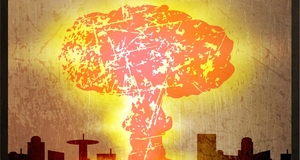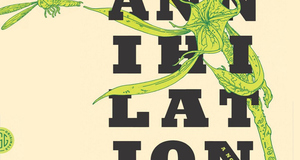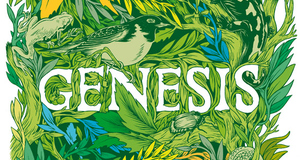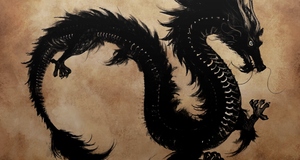From Discussions VOL. 11 NO. 1The Arcane and The Rational: Lovecraft's Development of a Unique MythosAbstractThe early 20th century saw the rise of a unique subgenre of science fiction and horror literature known as weird fiction. H.P Lovecraft, one of its more prolific and lasting contributors, is rightly considered one of the fathers of the genre. Like the rapidly modernizing world around him, Lovecraft developed his own universe and mythos that was itself a unique mix of old and new. He created monsters that would have been at home in fairy tales or the ancient mists of folklore. At the same time, these ancient, mythic evils were at odds with Lovecraft’s 20th century protagonists – men of education, breeding, and science. The inevitable result of their clash was death and madness on the part of the protagonist. Prior to Lovecraft, literature portrayed ancient religions and gods as benevolent protectors of mankind and the devout. Lovecraft subverted this and instead argued that the cosmos, and the god-like beings that reside there, are indifferent to the plight of man. Tempered by his own rationality and atheism, he created a world that was unique only in its insignificance. An avid reader, Lovecraft understood the prior works of writers like Milton and Dante, and the concept of higher and lower worlds that bookend our own place in the universe. Heaven, hell, and the earthly world were places of equal size and influence. However, Lovecraft’s writing rejected this and instead minimized the human realm to a sliver, sandwiched between the pitiless depths of an indifferent underworld below and an infinite, cold, and remorseless cosmos above. This paper studies how, through stories like “The Call of Cthulhu,” “At The Mountains of Madness,” “The Shadow Over Innsmouth,” and others, Lovecraft redefined both weird and traditional fiction. While perhaps unintentional, he nevertheless established new perspectives on science fiction and horror. In the early 20th century, a unique sub-genre of fiction emerged on the pages of magazines with titles like Weird Tales and Astounding Stories. The stories found therein were lurid tales of space exploration, alien monsters, ancient horrors, and strange worlds that bore an eerie and uncanny similarity to our own. These stories laid the basis for what would become the genre known as weird fiction. A mongrel mix of science fiction, fantasy, and horror – and sometimes all three – the stories contained within these “pulp” magazines laid the groundwork for the work of later writers, and some of them were the precursor to what would become a widely accepted subgenre of horror literature. It was amidst this exploration of unique fantasy and horror that one eccentric, bookish writer rose above his contemporaries. Through his writing, Howard Phillips Lovecraft, a reclusive descendant of New England’s founding fathers, created a unique mythos that remains an indelible part of horror writing and popular culture. Much has been written of Lovecraft – of his introversion, his quaintly anachronistic Victorian principles, and his reluctance to publish his work – and his legacy remains an undeniable part of American literature. The period during which weird fiction arose was unique, and Lovecraft and his fiction represented that uniqueness. Lovecraft was a patrician: a man born out of his time who lived his life as an English gentleman. At the same time, he was a rationalist, an atheist, and a learned man of scientific bent, with a love for astronomy and the hard sciences. These seemingly incongruous worldviews, rather than hindering him creatively, were what made him so powerful a writer. Lovecraft’s writing can be divided into three distinct periods. The first two consisted of less original works, pastiches of his two greatest influences: Edgar Allan Poe and Edward John Moreton Drax Plunkett, the 18th Baron of Dunsany (De Camp, 1975, p. 151). It was during his final period, however, when Lovecraft grew into his own as a writer and contributor to horror fiction. Commonly referred to as the Cthulhu mythos period in reference to his story and creature of the same name, this latter part of Lovecraft’s life – beginning roughly around 1925, after the dissolution of his marriage to Sonia Greene and his return to Providence from New York – is when his literary mastery reached its zenith (Joshi, 1997, p.6). To be precise, however, it should be noted that there is some overlap in the periods and that he composed literature indicative of the Cthulhu mythos period throughout his life, but the lion’s share of the works that are now considered as classic Lovecraft were mostly written after 1925. In the early 20th century, there was a powerful amalgam of science both at odds with and in reconciliation with the “old” and mythical. It was also a time of exploration, as there were still unexplored swaths of wilderness or barren locale and empty places on the map – places of mystery, wonder, and, possibly, terror. Likewise, Lovecraft’s monsters were beings of science, but also mythical in proportion. The people populating his universe were exemplary of this dichotomy as well – Lovecraft’s tales feature men of science, scholars who find solace in their knowledge and comfort in their modernity, as well as the backwoods voodoo of the uneducated and illiterate. Lovecraft’s heroes were reflections of himself – quiet, reposing, scholarly gentlemen who face the incomprehensibly backwards myths of a world long gone. The result of this irreconcilable mixing of the old and new was invariably madness and death for the protagonists and supporting characters. While there are three distinct traits that make Lovecraft’s Cthulhu mythos unique, the focus in this paper will be on the Cthulhu mythos, the development of Lovecraft’s unique literary mythology, and the role that location played on the development of his unique vision. Specifically, this paper will explore how Lovecraft’s worldview, his atheism, and his rationality subverted the standard archetypes of classical literature to create a distinctly different universe – a modern take for the 20th century, as it were. Prior to Lovecraft, the gods were looking out for us. Literary heroes were likely to survive because the gods were benevolent. Lovecraft changed that – he wrote of the indifference of the cosmos and the insignificance of man. Despite several thousand years of religious belief and the inherent hubris of humanity, Lovecraft posited that humankind, instead of being unique and the masters of all we see, was, in fact, insignificant when compared to the backdrop of the larger universe. Religious writings have argued that we are the center of the universe, but science has argued otherwise, and Lovecraft’s fiction falls squarely on the side of science. To Lovecraft, we are not the center of the universe; our impact on a cold and unforgiving universe is infinitesimal. Lovecraft said as much himself when he wrote to Farnsworth Wright, editor of Weird Tales, in July 1927: Now all my tales are based on the fundamental premise that common human laws and interests and emotions have no validity or significance in the vast cosmos-at-large. To me there is nothing but puerility in a tale in which the human form – and the local human passions and conditions and standards – are depicted as native to other worlds or other universes. To achieve the essence of real externality, whether of time or space or dimension, one must forget that such things as organic life, good and evil, love and hate, and all such local attributes of a negligible race called mankind, have any existence at all (Joshi, 2012, p.102). Lovecraft was aware that he was developing his own unique mythology. He was a voracious reader, selfeducated, and amazingly literate, and was undoubtedly aware of earlier explanations of the universe. The order and makeup of the world had been written about before in myths, but Lovecraft was moving in a different direction. The mythological world, and the plane where humans exist, has been explored numerous times throughout written history. However, there has been some commonality to the structure. At its simplest, the world is divided into realms: heaven, hell, and the central realm where humanity dwells – what was known in Old English and ancient Norse mythology as Midgard. This same Midgard, which J.R.R. Tolkien would put to use in the 1930s as Middle Earth in his own opus, The Hobbit and The Lord of the Rings, is a special place between the celestial bookends of the upper and lower worlds. This motif has resonated throughout literature, whether in the medieval concept of the hierarchal Chain of Being, or the delineated worlds of Milton in Paradise Lost. As Northrop Frye (2009) explained, …the physical world has usually been not only a cyclical world but a “middle earth” situated between an upper and lower world… The upper world is reached by some form of ascent, and is a world of gods, or happy souls…. The lower world, reached by descent through a cave or underwater, is more oracular and sinister (p. 58). In other words, this particular mythological view has been divided between a higher plane of good, where gods and angelic beings reside, a lower plane, Hell, where torment and demons await, and the middle ground, where we toil and strive to ascend. Earth and natural life reside in Middle Earth. There is also the underground, or underwater world, which is a place of punishment and darkness. It is from here that we must ascend – as Virgil wrote, “It is easy to go down into Hell; night and day, the gates of dark Death stand wide; but to climb back again, to retrace one’s steps to the upper air – there’s the rub, the task.” Lovecraft, while undoubtedly aware of this historic literary view, altered it to better match his own worldview. The changes, while subtle, were powerful in their implications. Lovecraft’s view of the mythological world was tempered by his own love for science and his own atheism; thus, Lovecraft did not have an upper level: There was no heaven. To Lovecraft, humanity is sandwiched between the dead, forgotten underworld and the cold, uncaring cosmos or higher level. As Fritz Leiber observed, “[Lovecraft] … altered the focus of the supernatural dread from man and his little world and his gods, to the stars and the black and unplumbed gulfs of intergalactic space” (Joshi 2012, p. 103). Examples of this worldview can be found in Lovecraft’s preference in the Cthulhu mythos for abandoned, forgotten places and the chance encounters his characters have with the cold and uncaring universe. In “At The Mountains of Madness,” a scientific expedition to Antarctica uncovers a monstrous mountain range and the remnants of an ancient city. There, amidst the unforgiving ice, the expedition discovers the corpse of a resident of the ancient city, a barrel-shaped and winged creature known as an “Old One.” The narrator, Professor William Dyer, and another member of the expedition arrive at the newly-established camp after the discovery only to find their comrades and their sled dogs dead, horribly mutilated by the Old Ones who were not dead, only frozen. The scientists, in their zeal for knowledge, had thawed them. Left to their own devices, Dyer and Danforth explore the city and discover through the study of the ruins and bas-reliefs in the Old Ones’ city that the Old Ones themselves were not the greatest threat. The Old Ones, as horrible as they were, were destroyed by their own creations, slaves and beasts of burden called shoggoths. Dyer and Danforth go deeper and deeper into the ruins, only to find a shoggoth. They flee the city, pursued by the creature, a horrifying, unnatural, insanitycausing “formless protoplasm” (Lovecraft, 2010, p. 312). In “At The Mountains of Madness,” we see some of the hallmarks of established mythology. In fact, while the Antarctic was a frequent location for pulp fiction of the era, Lovecraft went beyond the normal representation of it as a barren locale devoid of humanity. Elizabeth Leane (2005) observed in her article about the Antarctic as an alien space that Lovecraft, in placing “At The Mountains of Madness” where he did, centered his classic story on ideas and images that link the story “…with earlier literary and mythological constructions” (p. 227). Not only is there the earth and its inhabitants, represented by the scientific expedition, but there is also the labyrinth beneath the Old Ones’ city, representative of the underworld and a place of darkness and terror. However, Lovecraft altered the standard by giving the location a cosmic origin. The Old Ones came to Earth millennia ago from the stars. They were not of this earth, nor from heaven. They had God-like powers in their ability to manipulate genetics and create another race, much as God did with Adam and Eve. However, the creation of the shoggoths was less a matter of divinity and more one of practicality. The shoggoths were simply a readymade workforce that rose up and threw off its masters. The idea of tombs and underground catacombs that hide ancient secrets is replete throughout Lovecraft’s fiction. Whether it is the underworld of the city of the Old Ones in “At The Mountains of Madness,” or the forgotten tombs beneath the Australian desert in “The Shadow Out of Time,” or the horrifying catacombs beneath the Exham Priory in “The Rats in the Walls,” Lovecraft created an underworld of mind-boggling antiquity and decidedly inhuman origin. The underworld and the things found there supersede and deny human religions.Continued on Next Page » Suggested Reading from Inquiries Journal
Inquiries Journal provides undergraduate and graduate students around the world a platform for the wide dissemination of academic work over a range of core disciplines. Representing the work of students from hundreds of institutions around the globe, Inquiries Journal's large database of academic articles is completely free. Learn more | Blog | Submit Latest in Literature |



















